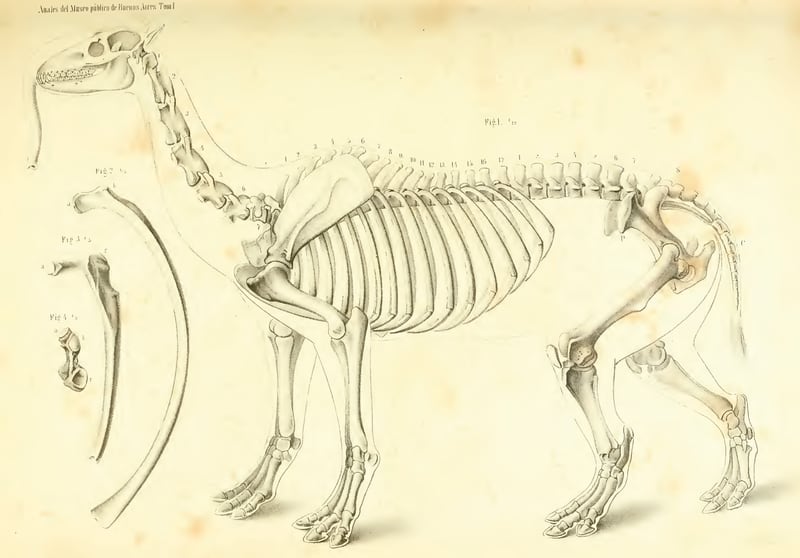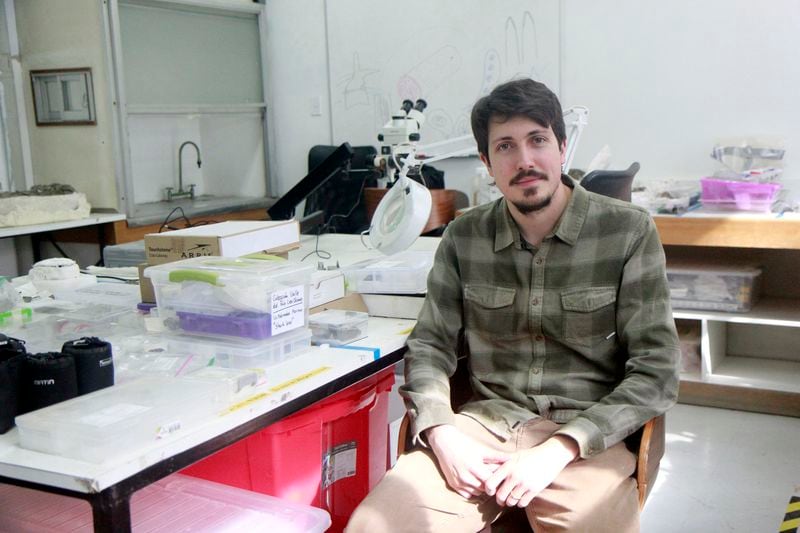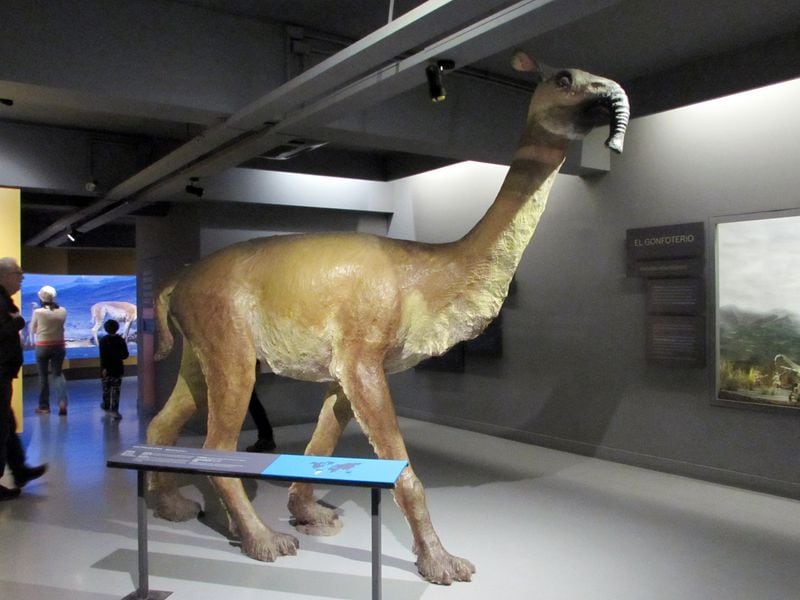The error was discovered by Hans Püschel, a researcher at the Paleontological Network of the University of Chile, who published this discovery in the Swiss Journal of Paleontology in collaboration with the Argentinian paleontologist Agustín Martinelli.
Charles Darwin, the famous English naturalist, recognized by the theory of natural selection as an explanation of the biological evolution of species, discovered in 1834 in Argentina, during the so-called “voyage of the Beagle”, the remains of a particular animal of large proportions.
These fragmentary remains were transported to England, where they were then studied by Richard Owen founder of London Natural History Museum And creator of the “dinosaur” concept. It was he who named this strange South American animal macrauchenia –Meaning of the Greek Compound Name “big neck” – the one he phylogenetically classified as Pachydermsan order of mammals currently excluded and which included animals such as elephants, rhinos, tapirs and hippos some of which, as we now know, are not closely related.
These were the first discoveries related to the Macrauchenia patachonica hoofed mammal (which walks with the end of the fingers and they have hooves) which is still considered an evolutionary enigma due to its curious anatomy . The famous native animal of South America, depicted in children’s films like the Ice Agewas the subject of study by Hans Püschel, researcher at the Paleontological Network of the University of Chile , who discovered that the scientific description of the species contained an error that no one had noticed for 159 years .
Chilean Corrects 150-Year-Old Mistake About Enigmatic Mammal Darwin Discovered
The discovery took place while he was carrying out the study that allowed him to identify a new species of this group of mammals that inhabited Chile, which he called Micrauchenia saladensis . As part of the review of materials for this work, the paleontologist realized that the bone of the atlas (vertebra which supports the skull) described for Macrauchenia patachonica had anatomical inconsistencies.
The finding was presented in a study published by Püschel in the journal Swiss Journal of Paleontology with the Argentine paleontologist Agustín Martinelli, work in which they determined that the atlas (the cervical vertebra which supports the skull) attributed by the literature to this species actually corresponded to that of a bovine, probably a large bull or a cow. According to the researcher from the University of Chile, “the importance of this research is that corrects a historical error in an emblematic species, which has been widely studied and included in many works and which was discovered by Darwin. So it’s unbelievable that during all these years this error has never been corrected, that no one has noticed it. This work corrects this and reports on an important anatomical problem in the species”.

Origin of a historical error
After Darwin’s discovery and Owen’s studies, in the second half of the 19th century new research has arisen around this group of mammals. One of the authors who continued the studies at that time was Herman Burmeister German naturalist, paleontologist and zoologist who moved to Argentina in 1861, where he became director of the Public Museum of Buenos Aires (now Bernardino Rivadavia Argentine Museum of Natural Sciences).
In this country, the scientist decided to work on some Macrauchenia leaves previously prepared by the French researcher Auguste Bravard, who died in the city of Mendoza during a major earthquake in 1861, to which he added the analysis of other materials existing in the museum which directed. From this work Burmeister made a description of several parts that had not been published on Macrauchenia, including the atlas.
“Until then the atlas was not known and it describes it with other parts of the material and even illustrates it in a publication, and this is what has remained scientifically until today. says Hans Püschel. The Chilean paleontologist says that while he was researching the Micrauchenia saladensis He examined the materials of many macrauchenids in different museums. “I went to the museum in Zurich, where they had an incomplete copy of macrauchenia, but that it had the complete cervical series, part of the skull, and parts of the forelegs. What’s interesting is that when I saw the atlas, I immediately said, “This doesn’t look like the atlas described by Burmeister in 1864!” “. After that, I begin to make a detailed study and I see that all the anatomical features do not coincide at all and, therefore, that the atlas described by Burmeister in 1864 did not correspond to the Macrauchenia”.

A very special mammal
Despite their resemblance to vicuñas or camels, macrauquénidos were not closely related to these animals, with which they shared the trait of having very elongated cervical vertebrae. “There is an evolutionary convergence between these two groups, because they are not related at all, but they are very similar, for example, in the anatomy of the neck. In fact, I think that’s what confused Owen at the time.” , explains the paleontologist from the University of Chile. Macrauchenia patachonica, in particular, is estimated to have weighed up to a ton, so it could be considered a fairly large mammal, with legs and a long neck.
It is also believed to have had a trunk at the end of its snout, a feature that remains one of the big questions about this animal. “His cranial anatomy is very interesting, since his nasal bone is very retracted, it is almost at eye level, very high, very far back in the skull, and that could be an indication that he had a proboscis, but not” . in reality, we know this because the soft tissue part has not been preserved. We can only note that its anatomy is very particular. There is even a study that suggests that he may have had a developed upper lip, like the moose, but this is something that is still under discussion,” explains Hans Püschel.
Are humans responsible for their extinction?
Most of the fossil remains of Macrauchenia patachonica the best known come mainly from the southern cone of South America, in particular the pampas and Argentine Patagonia. “In Chile, there are also reports, both in the north and in the south of the country. They had a lot of success. There is another species Xenorhinotherium bahiense, which is also known in Brazil, which is very similar, is related to and also lived in the Pleistocene”. Moreover, it has co-existed with humans for at least two millennia. “The last record is from the early Holocene, around 12,000 years ago. So obviously he was living with the humans because we know they were in South America. For example, in Monteverde, which has a date of more than 14 thousand years. So anyway, there was a coexistence for a few thousand years. » says the researcher.

For this reason, although evidence of direct hunting is unknown, it is thought that human presence may have been one of the reasons for their extinction. “Macrauchenia patachonica It is part of the megafauna that disappeared during the last ice age, and which coincided with the arrival of humans in South America. I’ve always thought that it’s the interactions with humans that affect their survival, mainly because we’re niche builders and we change our environment a lot, which impacts the species that live in the environment. It can be seen today and it has also happened before, maybe on a smaller scale, but it happened anyway,” says Püschel.
With that, indicates that there have also been very significant environmental changes . “We went from an ice age to an interglacial age, and then the ranges of species also changed. So, faced with the sum of these stressors, larger species, with longer life cycles, may have had more difficulty adapting. In any case, there is no evidence of direct hunting, nor of extermination, to my knowledge. But that doesn’t mean we have nothing to do with their extinction.”
The challenges around the Macrauchenia
The researcher of the Paleontological Network of the University of Chile maintains that there are still significant challenges regarding this group of mammals . He points out that many small studies have been published throughout history on different parts of the Macrauchenian skeleton, “but there is a lack of a publication that does some kind of monograph or more detailed work on the whole skeleton . I believe that still needs to be done, a more detailed analysis of the whole skeleton and with good pictures and illustrations, because everything is still very divided in terms of anatomical questions”.
On the other hand, he asserts that currently the biggest questions lie in the field of paleobiology. “There are many things that have not been done. Today there are new techniques to study, for example, locomotion, the way this animal moves, because even though it looks like a camel, it has very particular problems with its legs. For example, he has a very marked expansion of the radius of his front paw. I revisited this a bit when identifying Micrauchenia Saladensis, and in fact found no parallel with any living mammals. So it’s still a mystery, and I think it has to be solved with new techniques that look at, for example, the stresses on the bones, do force simulations and try to understand what kind of behavior of the animal has favored these constraints. types of adaptations, of bones”, indicates the paleontologist.
Source: Latercera
I am David Jack and I have been working in the news industry for over 10 years. As an experienced journalist, I specialize in covering sports news with a focus on golf. My articles have been published by some of the most respected publications in the world including The New York Times and Sports Illustrated.


